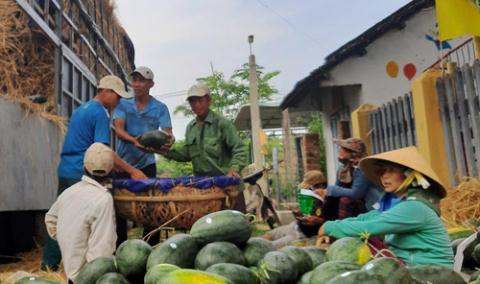- © Copyright of Vietnamnet Global.
- Tel: 024 3772 7988 Fax: (024) 37722734
- Email: evnn@vietnamnet.vn
chinese market
Update news chinese market
Material supply from China resumes, VN textile-garment companies sigh with relief
 In mid-March, when Chinese factories began resuming operation, material supplies to Vietnamese textile and garment enterprises were restored.
In mid-March, when Chinese factories began resuming operation, material supplies to Vietnamese textile and garment enterprises were restored.
The ‘farm produce rescue’ method
 Some retailers have reportedto the Ministry of Industry and Trade (MOIT) that there is no more farm produce to rescue. But farmers still complain that their farm produce remains unsalable.
Some retailers have reportedto the Ministry of Industry and Trade (MOIT) that there is no more farm produce to rescue. But farmers still complain that their farm produce remains unsalable.
Business production hit because of lack of materials from China
 Vietnam's reliance on Chinese materials has been clearly exposed during the Covid-2019 crisis, as imports from China have declined.
Vietnam's reliance on Chinese materials has been clearly exposed during the Covid-2019 crisis, as imports from China have declined.
VN farm produce exporters urged to look at markets other than China
 Exporters of agricultural products, especially dragon fruit, must improve quality and focus on the domestic and new export markets and reduce their dependence on the Chinese market amid the current epidemic outbreak, experts have said.
Exporters of agricultural products, especially dragon fruit, must improve quality and focus on the domestic and new export markets and reduce their dependence on the Chinese market amid the current epidemic outbreak, experts have said.
Farm exports to China blocked as coronavirus crisis worsens
 Problems have arisen in the first days of the Year of the Rat: the sale of farm produce to China has declined because of the coronavirus.
Problems have arisen in the first days of the Year of the Rat: the sale of farm produce to China has declined because of the coronavirus.
The US wants VN to cut tariff on farm produce
 Vietnam needs to learn from experiences from other regiolnal countries and take appropriate measures to protect domestic production, experts say.
Vietnam needs to learn from experiences from other regiolnal countries and take appropriate measures to protect domestic production, experts say.
VN Government cautious when setting export growth target in 2020
 Vietnam expects to see spectacular export growth rate in 2019 despite influences from the US-China trade war, but the government has decided to maintain the same export target for 2020.
Vietnam expects to see spectacular export growth rate in 2019 despite influences from the US-China trade war, but the government has decided to maintain the same export target for 2020.
Vietnamese dairy products officially allowed into China
 Vietnamese dairy products have been officially allowed into the Chinese market, according to a recent statement by the General Administration of Customs of China.
Vietnamese dairy products have been officially allowed into the Chinese market, according to a recent statement by the General Administration of Customs of China.
Vietnam struggles to reach rice export plan
 Analysts warn that Vietnam will have to struggle to implement the rice export plan this year because many key markets have tightened control over imports.
Analysts warn that Vietnam will have to struggle to implement the rice export plan this year because many key markets have tightened control over imports.
Vietnamese dairy producers face big problems
 Coca-Cola's announcement that it will enter the dairy sector will increase pressure on Vietnamese producers.
Coca-Cola's announcement that it will enter the dairy sector will increase pressure on Vietnamese producers.
Vietnam’s veggies and fruits can no longer cross the border to enter China
 Vietnam’s vegetables and fruits are finding it difficult to enter China, but the country continues to import Chinese products in large quantities.
Vietnam’s vegetables and fruits are finding it difficult to enter China, but the country continues to import Chinese products in large quantities.
Farm produce: selling much, but making little profit
 Official reports all show that exports of farm produce have increased sharply since the beginning of the year, but the value is very low.
Official reports all show that exports of farm produce have increased sharply since the beginning of the year, but the value is very low.
Chinese farm produce market choosier, causing concern among exporters
 Vietnam’s businesses have had to change the way of organizing production to satisfy the increasingly high demand from China.
Vietnam’s businesses have had to change the way of organizing production to satisfy the increasingly high demand from China.
Wood chip exports stuck on the way to China
 As the biggest wood chip exporter in the world, Vietnam is facing big difficulties.
As the biggest wood chip exporter in the world, Vietnam is facing big difficulties.
Vietnam's rice exports to China plunge
 Instead of continuing to be an easy-to-be-please rice importer, China has been reducing imports, showing its ambition to become an exporter.
Instead of continuing to be an easy-to-be-please rice importer, China has been reducing imports, showing its ambition to become an exporter.
Vietnam’s rice exports drop, causing big worries
 Over the last 10 years, rice exports have brought $2-3 billion to Vietnam a year. However, they are facing difficulties in nearly all key markets this year.
Over the last 10 years, rice exports have brought $2-3 billion to Vietnam a year. However, they are facing difficulties in nearly all key markets this year.
Vietnam's dairy producers vow to make bigger investments
 It is expected that the average dairy product demand of Vietnamese will increase to 28 liters per annum by 2020.
It is expected that the average dairy product demand of Vietnamese will increase to 28 liters per annum by 2020.
VN’s agricultural products face barriers to enter Chinese market
 Many of Vietnam’s agricultural products – especially rice, vegetables and cassava – have faced barriers preventing their export to China, according to the Ministry of Agriculture and Rural Development.
Many of Vietnam’s agricultural products – especially rice, vegetables and cassava – have faced barriers preventing their export to China, according to the Ministry of Agriculture and Rural Development.
Fruit exports: China changes rules, Vietnam changes strategy
 Vietnam’s fruit exports to China in Q1 decreased by 6.3 percent compared with the same period last year. The door to the biggest export market is narrowing.
Vietnam’s fruit exports to China in Q1 decreased by 6.3 percent compared with the same period last year. The door to the biggest export market is narrowing.
Vietnam’s producers meet difficulties as yuan weakens.
 In an effort to encourage exports in the context of the trade war, the Chinese central bank PBOC has set the yuan/US dollar reference exchange rate at 6.8365 yuan per US dollar, the lowest level since January 2019.
In an effort to encourage exports in the context of the trade war, the Chinese central bank PBOC has set the yuan/US dollar reference exchange rate at 6.8365 yuan per US dollar, the lowest level since January 2019.



















